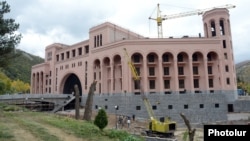Armenia’s construction industry, once the engine of robust economic growth, expanded slightly in the first quarter of 2014 after several consecutive years of rapid decline, according to official statistics.
The National Statistical Service (NSS) reported this week that output in the sector increased by 0.7 percent year on year to almost 40 billion drams ($96 million).
More detailed NSS figures for January-February show that this modest growth was driven by a 25 percent surge in construction projects financed by the Armenian government. The more large-scale housing construction carried out by private firms and individuals grew more slowly.
The sector’s first-quarter growth was dragged down by a sharp fall in external donor funding for road and other infrastructure upgrades.
A construction boom was the main reason why the Armenian economy grew by an average of 12.5 percent from 2001-2007. That came to an abrupt end in late 2008 with the onset of a global financial crisis that hit the Armenian economy hard. The construction sector contracted at double-digit rates in the following years, hampering the country’s economic recovery.
Gagik Minasian, the chairman of an Armenian parliament committee on economic affairs, described the sector’s first-quarter performance as encouraging on Friday. “For a long time after the crisis we registered a decline in construction,” he told RFE/RL’s Armenian service (Azatutyun.am). “We now have growth in construction, even if it’s modest.”
Whether that growth will continue in the coming months is far from clear, however. In a recent report on Armenia, the World Bank offered a “modest” outlook for construction and agriculture, saying that “the main drivers of growth will have to be industry and modern services competing in international markets.”
The National Statistical Service (NSS) reported this week that output in the sector increased by 0.7 percent year on year to almost 40 billion drams ($96 million).
More detailed NSS figures for January-February show that this modest growth was driven by a 25 percent surge in construction projects financed by the Armenian government. The more large-scale housing construction carried out by private firms and individuals grew more slowly.
The sector’s first-quarter growth was dragged down by a sharp fall in external donor funding for road and other infrastructure upgrades.
A construction boom was the main reason why the Armenian economy grew by an average of 12.5 percent from 2001-2007. That came to an abrupt end in late 2008 with the onset of a global financial crisis that hit the Armenian economy hard. The construction sector contracted at double-digit rates in the following years, hampering the country’s economic recovery.
Gagik Minasian, the chairman of an Armenian parliament committee on economic affairs, described the sector’s first-quarter performance as encouraging on Friday. “For a long time after the crisis we registered a decline in construction,” he told RFE/RL’s Armenian service (Azatutyun.am). “We now have growth in construction, even if it’s modest.”
Whether that growth will continue in the coming months is far from clear, however. In a recent report on Armenia, the World Bank offered a “modest” outlook for construction and agriculture, saying that “the main drivers of growth will have to be industry and modern services competing in international markets.”




